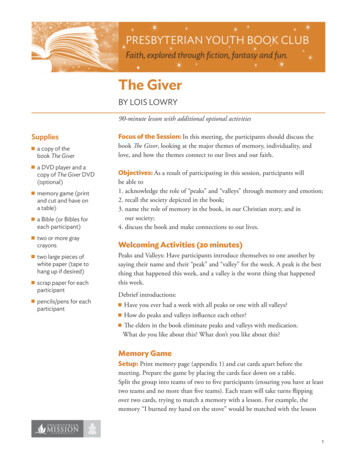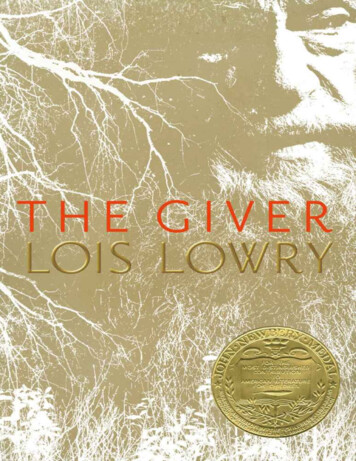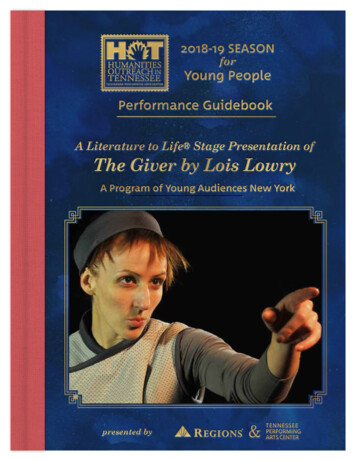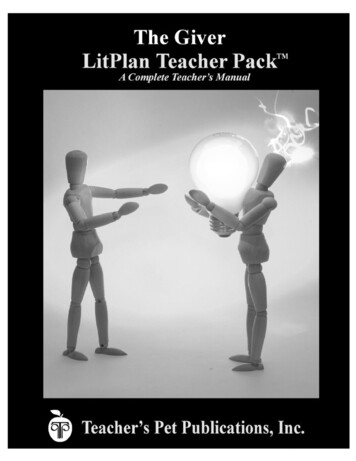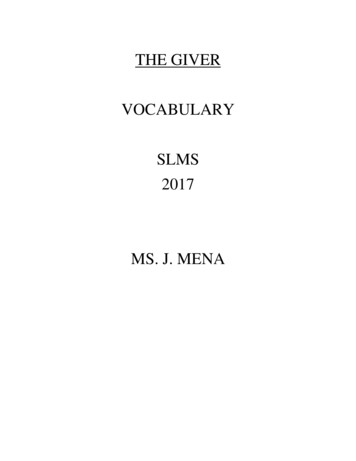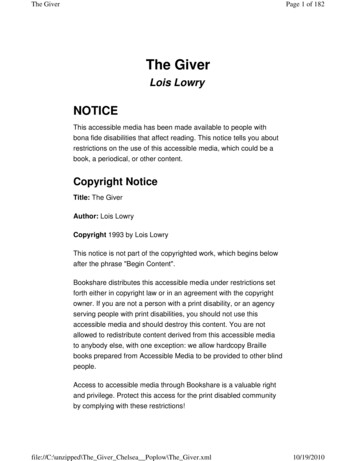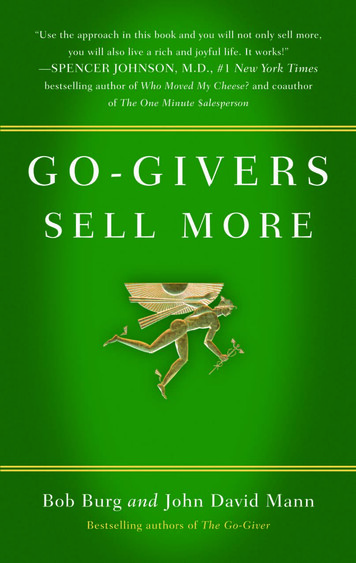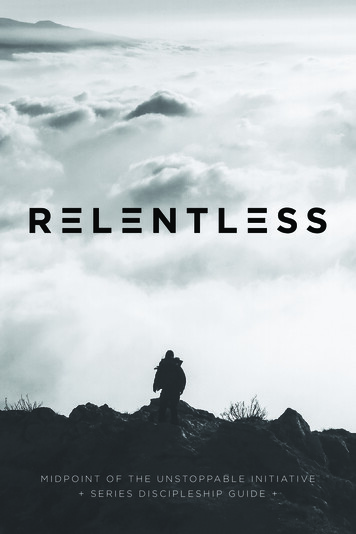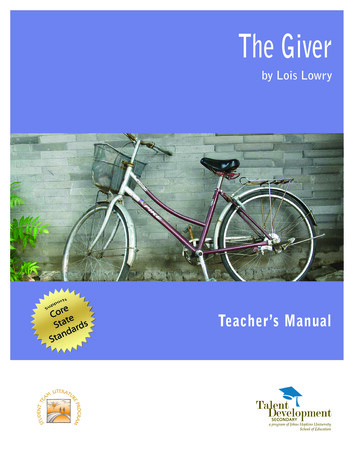
Transcription
The Giverby Lois LowryTeacher’s Manual
Teacher’sM A N UA LtoThe GiverDell Laurel Leaf, 2002By Maria Garriott andAnn MaouyoTalent Development SecondaryCenter for Social Organization of SchoolsJohns Hopkins UniversityBaltimore
2014 by Johns Hopkins Talent Development, All Rights ReservedThese materials were developed by the Talent Development Secondary Program ofThe Center for Social Organization of SchoolsThe Johns Hopkins University, C.S.O.S., 2701 N. Charles Street, Suite 300, Baltimore, Maryland 21218Permission is granted to copy and distribute reproducible pages only for classroom use. Other reproductions withoutpermission are prohibited.Cover photos: ?image 16348&picture old-bicycle
Table of ContentsTo the TeacherTalent Development Secondary ProgramiPlanning and preparation1Chapters 1 - 54Chapters 6 - 1121Chapters 12 - 1635Chapters 17 - 2351Selection Review reproducibles67Literature Test reproducibles75Vocabulary Test reproducibles83
TALENT DEVELOPMENT SECONDARY (TDS)ENGLISH LANGUAGE ARTS DIVISIONMISSION STATEMENTE atePL licM upSA t DoNDRESPONDING TO THE CHANGING NATURE OF LITERACY BY PROVIDINGSTUDENTS WITH SKILLS THAT WILL ENDURE BEYOND THE CLASSROOMoStudent Team Literature Discussion Guides are designed to support teachers with organizing literacyinstruction to respond to the needs of diverse student populations while striving to meet the growinginstructional demands of state and district college- and career-readiness standards.Using whole-class structures, peer discussion, and teacher modeling, this instructional frameworkaffords students regular opportunities to engage in oral language, critical analysis and exploration ofinformation extending to real world applications. Students intuitively deepen understanding of contentand develop their inferring and evidence-gathering skills through ongoing exposure to inductivelearning, a powerful strategy underlying higher-order thinking and 21st century skills. Teachers routinelyfacilitate small-group and whole-class discussions to help students apply academic language and developnew insights and perspectives as they read various types of authentic texts. Teachers are alsoencouraged and equipped to use a variety of informational texts in conjunction with literary works, andto provide students with the skills they need to comprehend these increasingly complex texts. Throughreading and writing for different purposes and from multiple perspectives, students move toward theself-regulated learning and independent thinking required to function in today’s society.In the midst of the flow of information surrounding adolescent literacy, we recognize the significant rolethat motivation plays in the lives of adolescent learners. The instructional design and materials used inthe TDS program enable students to exercise mental processes needed to comprehend, communicate,reason, evaluate, and persevere. Students take ownership of learning experiences and make choiceswithin a responsive, student-centered classroom environment.With the growing demands of the 21st century, the TDS ELA Discussion Guides offer flexibility andguidance to teachers who seek specific focus and clarity when planning instruction. Teachers are able tobuild instructional modules around core reading selections using existing approaches and activitiescontained in the Discussion Guides. This approach helps establish historical and factual connections, andaddresses specific assessments, standards and skills in the context of teaching the core readingselections. Using this method to planning and teaching literacy, classroom teachers and TDSinstructional support staff can effectively collaborate around core approaches to promote achievementfor all students in the 21st century.
TEACHER’S MANUALTo the TeacheriTo the TeacheroE atePL licM upSA t DoNDThis Teacher’s Manual is part of a research-based, cooperativeapproach to teaching literature developed by the Talent DevelopmentSecondary Program at the Johns Hopkins University. This approach,called Student Team Literature, strengthens students’ thinking,reading, writing, and social skills. In Student Team Literature, students read quality books and work in learning teams using StudentDiscussion Guides that lead them to become critical thinkers, expand their working vocabularies, and broaden their knowledge ofthe writer’s craft. Guides are available to support study of over 70novels, biographies, and short story and poetry collections. Studentsread the literature and work through a Student Discussion Guideusing a weekly cycle of instruction.Each Student Discussion Guide includes the following components: Vocabulary Lists expose students to terms they need to knowin order to understand what they are reading. Starred High Frequency Words are those that students acquire for their working vocabularies, as they occur often inmany contexts. Students learn to use these words in meaningful sentences that include context clues to show understanding of the new words. Writer’s Craft Boxes provide information about aspects of thewriter’s craft (e.g., flashbacks, figurative language) that students encounter in the literature. Craft Boxes can be used asthe basis for mini-lessons. Questions and Graphic Organizers lead students to analyzethe literature, organize information, and better understand thewriter’s message. Make a Prediction and What If? Boxes lead students to establish expectations about what will come next in their reading. Selection Review questions and answers are used by pairs ofstudents to prepare for literature tests. Literature-related Writing suggestions lead students to respondto literature and try various forms of writing. Extension Activities give students opportunities to expressthemselves in response to the text through art, drama, research, and other activities.Talent Development Secondary Program
iiTEACHER’S MANUALTo the Teacher So, You Want to Read More suggests books for independentreading that match the one students have read in theme,genre, or topic.In addition to these sections, each Teacher’s Manual also includes:oE atePL licM upSA t DoND About the Author provides biographical information, as well aslisting some of the writer’s other works. a Summary of the book or literary work a Building Background section with suggestions for preparingstudents to read the literary work a Preview/Predict/Purpose section with questions that leadstudents to establish expectations before beginning to read Guided Discussion questions and suggestions for whole-classdiscussions Listening Comprehension/Read Aloud Connections identifying relevant literary elements and devices and listing shortworks that include these features, which teachers can use toprepare and present Listening Comprehension lessons (ateacher read-aloud/think-aloud activity that serves as a companion to Student Team Literature)These materials can be used within or outside the context of theStudent Team Literature program, although we believe teacherswho have been trained in the program make the best use of them.(Please see below for teacher training contact information.)About the LiteratureThe most effective motivation for adolescent readers lies in therelevance of the literature they are presented. Poor or reluctantreaders are particularly in need of relevance in the written word.They need to see themselves in the pages they turn.Today’s adolescents are fortunate; never have they had so muchquality literature available that reflects their experiences, theirproblems, and their cultures. The driving force behind StudentTeam Literature is making accessible the best of middle grades literature. Discussion Guides have been written for a wide variety ofliterary works at every readability level, from high interest/lowreadability selections to classic literature used in middle gradesEnglish language arts instruction for over twenty-five years.Talent Development Secondary Program
TEACHER’S MANUALTo the TeacheriiiThe Weekly Instruction CycleoE atePL licM upSA t DoNDDiscussion Guides enable teachers to lead learning teams throughliterary works in a cycle of activities that includes direct instruction,team practice and discussion, and individual assessment. Aftercareful preliminary vocabulary instruction, students: (1) read aselected text portion silently; (2) complete (optional) PartnerReading, which gives poor readers and second language learnersadditional practice to build fluency by reading excerpts aloud; (3)discuss with their partners possible responses to questions andactivities in Student Discussion Guides; and, (4) write individualresponses to the questions and activities.Discussion Guides and Cooperative LearningDiscussion Guides are designed to be used in the classroom inthe context of cooperative learning. Cooperative learning requiresstudents to learn and exercise many social and academic skills,beginning with the most basic, such as active listening and stayingon task. For that reason, introducing students (and teachers, during professional development) to Student Team Literature typicallyinvolves direct instruction in relevant skills. The teacher determines the skills to be taught (one at a time), the order in whichthey will be introduced, and students’ readiness to add new skills.Instruction includes discussion of the skill and its importance;completion of a T-chart to show what the skill looks and soundslike (making abstract social skills more concrete for students); andmodeling and role-playing use of the skill. As students apply theskills in daily classroom activities, teachers monitor and reinforcetheir use. Students gradually internalize the skills, creating a cooperative learning climate that has an important positive impact onclassroom management and academic achievement.AssessmentThree assessment tools are available to teachers who use StudentTeam Literature guides. Each week, after quizzing each other in aprocess called “Selection Review,” students take literature teststhat require short constructed responses. Vocabulary tests assessstudents’ ability to compose meaningful sentences using the highfrequency words they have studied in the context of the literature.These Selection Reviews, literature tests, and vocabulary testsare provided on reproducible pages at the end of each Teacher’sManual. In addition, students can practice their standardized testTalent Development Secondary Program
ivTEACHER’S MANUALTo the Teachertaking skills in relation to the literary work they have studied bytaking Standardized Reading Practice Tests that are similar in formatto the standardized tests used in school districts throughout thecountry. Standardized Reading Practice Tests must be ordered separately.The Talent Development Secondary program offers Teacher’sManuals, Student Discussion Guides, and a Standardized ReadingPractice Test booklet including reproducible assessment pages.oE atePL licM upSA t DoNDOrdering information To place an order, call 410-516-4339 or email tds@jhu.edu. Thecomplete Talent Development Secondary materials catalog isavailable online on our website (see below). For teacher training or more on our English language arts, math,science, or social studies programs, contact Maria Waltemeyerat 410-516-2247 or mwaltemeyer@jhu.edu Also visit our website ent Development Secondary Program
TEACHER’S MANUALPlanning and Preparation1The GiverAb o u tT he Au t h orBy Lois LowryTEACHER’S MANUALSuggested length of time to be spent on this novel: 4weeksoE atePL licM upSA t DoNDLois Lowry was bornin 1937 in Hawaii.She learned to readbefore she was fouryears old, anddecided to becomean author. “I remember the feeling ofexcitement that I had,the first time that Irealized each letterhad a sound, and thesounds went togetherto make words; andthe words becamesentences, and thesentences becamestories. I was veryyoung--not yet fouryears old. It was thenthat I decided thatone day I would writebooks.” Lowry's father, an officer in theArmy Dental Corps,was away from homeduring much ofLowry's childhood.“That's probably whyI've written a terrificfather figure intoalmost all of mybooks -- sort of afantasy of mine whilegrowing up,” shesays. Lowry skippedtwo grades and wasthe youngest, usuallythe smallest, in everygrade. She attendedBrown University fortwo years, then leftschool to marry. Sheraised four children(cont.)Talent Development Secondary ProgramSummaryThe Giver tells the story of Jonas, a twelve-year-old boy who lives ina futuristic community strictly organized and governed by a Committee of Elders. In Jonas’ community, everything is predictable,orderly, and painless. However, the people have no choices, nomemories of the past, no color, no music, and no deep emotions.At age twelve, every person is assigned a role in the community.When Jonas’ turn comes, he is selected to be the community’snew Receiver of Memory. Only the Receiver carries the community’s memories of pain, pleasure, and love.When Jonas begins his training with the Receiver (who now tellsJonas to call him the Giver, as he considers Jonas the new Receiver) his whole view of the community is turned upside down.He begins to realize that his community is not humane; that thepeople can never really be happy; and that the true meaning oflove and family are foreign to all but himself and the Giver.Jonas realizes, with the Giver, that things must change. Butchange will demand a heavy price from Jonas, who must leave thesafety and security of the community forever. He and the Giverbegin to devise a way for Jonas to escape the community, leavingthe memories behind to be absorbed by the people.When Jonas’ little brother Gabriel is scheduled for “release” (execution), Jonas abandons his carefully designed escape plan andflees, taking the toddler with him. As Jonas pedals away in searchof the elusive Elsewhere, he learns about sacrificial love and truecommunity.
2TEACHER’S MANUALPlanning and PreparationBuilding BackgroundAb o utT h e Auth orD(cont.)oE atePL licM upSA t DoNand worked as a freelance writer andphotographer beforebecoming a novelist.Lowry won the 1994Newbery Medal forThe Giver. She oncetold an interviewerthat her purpose wasin writing books foryoung people was “tomake a reader feelless alone. Adolescence is very often apainfully lonely time;and it is a time whencommunication isdifficult. A book canbe a vehicle forcommunication; anda book can alleviatethe sense of isolationthat sometimesmakes growing uplonely.” Other booksby Lois Lowry includeA Summer To Die;Find a Stranger, SayGoodbye; the Anastasia Krupnik series;Autumn Street; TheOne Hundredth ThingAbout Caroline;Rabble Starkey;Number the Stars; andYour Move, J.P.! Shehas also written twoother books that gowith The Giver:Gathering Blue andMessenger.It is not surprising that The Giver has won a handful of nationalawards: it is thematically rich, extremely well-crafted, and bothtimeless and timely. The book interweaves themes of freedomand control, love and sacrifice, community and individuality, andbelonging and rejection. To introduce the book, challenge studentsto envision their own utopia, an ideal community they would design and inhabit. What would such a community look like? Howwould individual freedom and self-determination dovetail with theconcept of conformity and self-sacrifice for the community?Tell students that The Giver is a science fiction novel; it is set at anindefinite time in the future. Some science fiction focuses on possible technological advances that could occur in the future, butthis novel is more interested in ways that society itself, and socialrelationships, might be different in the future. Encourage students to pay attention to clues – some of them quite subtle –about ways that Jonas’ society is different from ours. Science fiction writers usually base their speculations about the future ontrends that they observe in our world today. Encourage students tothink about present-day trends that the author might have beenthinking about when she imagined how a future society wouldwork. Students will also notice that in some instances the authormakes up new words, or new ways to use old words, which she ascribes to this futuristic society. The meaning of the new words isusually fairly easy to guess, but in some instances their exactmeaning becomes clear only gradually.Listening Comprehension/Read Aloud ConnectionsBasic plot elements, including exposition, conflict and complication, and a subplot, are highlighted in this novel . For examples ofplot elements, read Kate Duke’s Aunt Isabel Tells A Good One,Judi Barrett’s Cloudy With A Chance of Meatballs, BernardWaber’s Ira Sleeps Over, William Hooks’ Moss Gown, or Ralph’sSecret Weapon by Steven Kellogg. Suspense is also an importantfeature of The Giver. A good example of suspense is found inRachel Isadora’s At the Crossroads.Talent Development Secondary Program
TEACHER’S MANUALPlanning and Preparation3Preview/ Predict/ PurposeDS o , Yo uWa n t To ReadMoreHave students predict what might happen in the story. What doesthe Giver give the community? How will Jonas’ special trainingchange his life?oE atePL licM upSA t DoNIf you enjoyed TheGiver, you may enjoyA Wrinkle in Time byMadeline L'Engle,which describes theadventures of severalchildren who travelback and forth intime, or The House ofthe Scorpion, a science fiction novel byNancy Farmer.To preview this novel, have students read and think about thefront and back covers and the title of the book. What would it belike to live in a “perfect” world? What could this mean? Why isone member of the community called the Giver? How would youdescribe the face of the man on the cover?Talent Development Secondary ProgramEncourage students to use their predictions to set a purpose forreading, such as “I’m going to read to find out what happens toJonas in his ‘perfect’ community.”
4TEACHER’S MANUALChapters 1-5Discussion Guide #1Chapters 1 - 5 (pages 1-39)oE atePL licM upSA t DoNDWrite the starred words on the VOCABULARY LIST on the nextpage and their definitions on chart paper or sentence strips thatwill remain posted throughout the time that students work on theDiscussion Guide.Prepare a Vocabulary Prediction Chart (see illustration below) forstudents to complete after you have introduced the reading selection and the VOCABULARY LIST, and before they have begun toread. The chart contains categories into which starred words fromthe list are to be placed. Students predict how each starred wordrelates to the reading selection, or if it is impossible to predict itsrelationship. Categories can be adjusted according to the type ofliterature being read.SettingCharactersStarred itudeNo PredictionFirst, read aloud the list of words in the order in which they appear.Second, reread the words and have students repeat each one afteryou. Third, ask students if they know the definitions of any of thewords. Confirm correct definitions, or, in the case of multipleTalent Development Secondary Program
TEACHER’S MANUALChapters 1-5oE atePL licM upSA t DoNDmeaning words, identify definitions that match the context in whichthe words are used in the story. Next, ask students if they recognizeparts of unfamiliar words. If students’ decoding skills are belowlevel, stress at this time the sounds of syllables — especially instarred words. In all cases, use this time to focus on identifying themeanings of any prefixes, suffixes or roots that are contained in unfamiliar words, and lead students to formulate definitions basedupon the meanings of their parts. (Prefix, suffix, and root meaningsare provided in the glossaries for starred words that contain easilyidentifiable word parts.) Finally, provide definitions for any wordsthat remain undefined. (Definitions of starred words are in theglossaries that follow the Vocabulary Lists. Definitions are notprovided for the other words in the Vocabulary Lists.)5Reread the list in random order and have students repeat eachword after you. Then point to the words in random order and havethe students pronounce each one without your assistance. Returnto any words that students have difficulty pronouncing until they canpronounce them correctly. This process will be repeated each daythat students are working on a particular Discussion Guide, so ifstudents still have difficulty pronouncing some of the words, theywill have other opportunities for practice and correction.Next, lead students in completing the Vocabulary Prediction Chart.The importance of this activity lies in encouraging students to makelogical connections between what they have been told about thereading selection and specific vocabulary words. Being correctabout predictions is not important; the thought process requiredto make predictions is. The graphic organizer should be put onchart paper so that the list can remain posted as students read thesection of the reading selection in which the words first appear. Introduce words in subsequent Discussion Guides similarly.Vocabulary List A*distraught (p. 4)*ironic (p. 2)soothed (p. 9)palpable (p. 3)*intrigued (adj., p. 1)Talent Development Secondary Program*ritual (p. 5)transgression (p. 9)*aptitude (p. 15)navigational (p. 2)*apprehensive (p. 4)hatchery (p. 4)*disposition (p. 7)supplementary (p. 7)prominent (p. 8)
6TEACHER’S MANUALChapters 1-5Glossary of Starred Wordsdistraught - very upset; troubled; franticironic - mocking; sarcasticoE atePL licM upSA t DoNDapprehensive - nervous; uneasy; somewhat worriedintrigued - curious; very interestedaptitude - a talent; a giftSample Meaningful Sentences for Starred Words1. Mom was very distraught when she lost her bus pass becauseshe had no money to buy another one, and she needed it to goto work.2. I was excited about taking karate lessons, but also a little apprehensive because I didn’t know whether or not I would do well.3. “So, Sherman, did you get your beauty sleep this morning?”the teacher asked in an ironic tone, as she handed him a detention slip for being late for the third time that week.4. Maria has spent hours looking through her library book becauseshe is so intrigued by the many different and unusual creaturesfound in the insect world.5. Jorge has a great deal of musical aptitude, but he needs tostudy and practice his instrument in order to turn all that natural talent into real skill.Talent Development Secondary Program
TEACHER’S MANUALChapters 1-57The Writer’s CraftIn the first part of a story, the exposition, the author setsthe scene. We learn about the characters and the setting –the time and place in which the action occurs. We learnsome of the background of the story. We might begin tosuspect what problems the characters will have to face – inother words, the story’s conflict.oE atePL licM upSA t DoNDExpos ition and Flas hbacksOften, the writer may use flashbacks to do this. Flashbacksare descriptions of events that occurred before the beginning of the story itself. The writer can bring these upthrough a character’s memories, or through conversationsor dreams. When you read a story containing flashbacks,make sure you know which events are taking place at thetime of the story, and which ones took place earlier.As you read this section of The Giver, see how much youcan learn about Jonas, his family, and his friends. Also seehow much you can learn about Jonas’ community (the setting of the story). Where do you think the conflict in thestory might come from?Talent Development Secondary Program
8TEACHER’S MANUALChapters 1-5D I S C U S S I O N Q U E S T I O N S A N D AC T I V I T I E S1. Describe the setting (time and place) in which this story occurs. Why do you think the incident with the unidentifiedplane is so frightening to Jonas? The story takes place sometime in the future. The setting is Jonah’s community, but weare not told its name or geographical location. The communityis very tightly governed, and Jonas knows that planes are notpermitted to fly over the community. This security breachalarms him. Like other community members, he is confusedand deeply unsettled by any departure from the expectedrules.oE atePL licM upSA t DoNDSection I. Read chapters 1 and 2 (pages 1-19). Discuss the answers to the questions with a classmate. Then write your answersindependently.2. Although Jonas and Asher are good friends, their personalities are very different. In the Venn diagram below, list somesimilarities and differences between Jonas and Asher. Somepossible answers are shown.Jo nasstudious andthoughtfulcareful inhis use oflanguageBothAsher11 years oldlike to have funcarefree andabsentmindedfriendly andcheerfuloften mixesup his words3. List several rules that the people in Jonas’ community mustobey. Answers may vary. Possible answers include the following: Aircraft are not allowed to fly over the community. Community members must obey the Speaker instantly. Communitymembers must use precise language. Apologies are requiredfor all offenses. Each family may have one male and one female child. It is forbidden to hide feelings. Infants are not to becalled by name until they undergo the Naming Ceremony in December. The Committee of Elders assigns young people theirjobs at the ceremony that takes place in December of theirtwelfth year.Talent Development Secondary Program
TEACHER’S MANUALChapters 1-59Prior to that time, children are expected to do volunteer servicein whichever workstations interest them.oE atePL licM upSA t DoND4. What are some of the rituals in Jonas’ community? What istheir purpose? The telling of feelings encourages communication and bonding between family members, At the same time,it means that no feelings are ever allowed to remain private.Yearly ceremonies in December mark the passage of childrenfrom one age group to another, including changes in their privileges and responsibilities. The ceremony of Twelve marks theend of childhood.5. What job does Jonas’ father have? Why did he break a ruleat his job? Jonas’ father is a Nurturer who takes care of babies during their first year of life. He has been worried aboutone of the male Newchildren who is not doing well. Jonas’ father looked up the name of the struggling Newchild, numberThirty-Six, even though the child has not been publicly namedat the Naming Ceremony. He did this because he thought thatcalling the child by name might provide better nurturing.6. List the different reasons that can lead to someone being“released.” What is the same in all cases? What is different,depending on the circumstances? What do you think theterm “released” really means? Several different situationscan lead to someone being released. Newborn children may bereleased if they are seen as not developing normally. This isconsidered a sad situation, because they have not had achance to enjoy life in the community. When the elderly are released, however, there is rejoicing as the community celebrates a life well lived. In all other cases, however, release is apunishment. An adult may be released for making a grievouserror, such as that of the pilot who mistakenly flew a jet overthe community, or for deliberately breaking the rules a thirdtime after two warnings. In this case, the release is considereda sign of terrible failure and disgrace. These situations arenever again mentioned afterwards. Answers may vary as towhat students think the term “released” really means (seeGuided Discussion, below).Talent Development Secondary Program
10TEACHER’S MANUALChapters 1-5Guided Discussion:M a ke AP red ic t io n:DoE atePL licM upSA t DoNWhat job do you thinkJonas might be assigned at the Ceremony of Twelve?What about Asher?Discuss some of the questions in Section I. In addition,feel free to include in the discussion questions that are notin the Discussion Guide, such as: Did you notice any newwords, or old words used in new ways, in the chapters weread? One new word is the compound word “newchildren,”used to describe infants who have not yet undergone theNaming ceremony and have not yet been placed in families. One word that is used with a change in meaning is theword “released.” Although answers to question #6 mayvary, many students may have guessed that “released”means “killed.” This is carried out because the personsconcerned are considered too flawed to continue living (asin the case of newborns), no longer useful to the community (as in the case of the elderly), or unworthy of life because they have committed unpardonable crimes ormistakes (as in the case of the pilot who misread his instructions and flew over the community). If students arestill unsure of the meaning of the word, do not confirm ordeny their guesses; encourage them to keep reading tofind out whether or not they are right.Another word that is used in an unusual way is the word“animals” (pp. 5-6). We read, “Neither child knew what theword meant, exactly,” and later (p. 18) the children’s “comfort objects,” a bear and an elephant, are described as“imaginary creatures.” Ask students what these commentsimply about Jonas’ community. (They suggest that themembers of the community have no knowledge of real animals and do not even know exactly what the term means.)Ask students to describe the Committee of Elders and tellwhat it does. The Committee of Elders governs the community. This includes making Assignments and approving applications for Newchildren. Also ask students, What doesJonas’ community value? What is missing in the community? How can you tell? Would you like to live in Jonas’community? Why or why not?Talent Development Secondary Program
TEACHER’S MANUALChapters 1-511Vocabulary Prediction Check-upoE atePL licM upSA t DoNDReturn to the vocabulary prediction chart, and use it to checkthe predictions students made prior to reading this section ofthe reading selection. Remind student
The Giver By Lois Lowry TEACHER’S MANUAL Suggested length of time to be spent on this novel: 4 weeks Summary The Giver tells the story of Jonas, a twelve-year-old boy who lives in a futuristic community strictly organized and governed by a Com-mittee of Elders. In Jonas’ com


